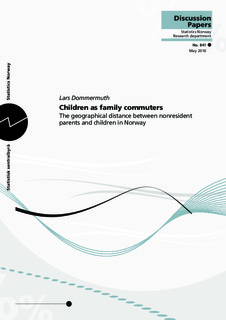| dc.contributor.author | Dommermuth, Lars | |
| dc.date.accessioned | 2018-10-31T12:12:30Z | |
| dc.date.available | 2018-10-31T12:12:30Z | |
| dc.date.issued | 2016-06-07 | |
| dc.identifier.uri | http://hdl.handle.net/11250/2570379 | |
| dc.description.abstract | As union dissolution rates increase in most modern societies, a growing number of children are living in post-separation families.
The geographical distance between parental households shapes the possibilities for contact between nonresident parents and children, but empirical studies are lacking. This study investigates the geographical distance between nonresident parents and children in Norway using a total population sample, including exact geographical coordinates for residency. Results show that most children are registered in the maternal household after parents’ union dissolution. The majority of nonresident parents live within a 10 km radius of their child, but the average distance is greater for nonresident fathers than for nonresident mothers. If children move from one parental household to the other, this is associated with longer distances, especially to nonresident mothers. Low household income of nonresident parents is correlated with longer distances between the parental households. | nb_NO |
| dc.language.iso | eng | nb_NO |
| dc.publisher | Statistisk sentralbyrå | nb_NO |
| dc.relation.ispartofseries | Discussion Papers;No. 841 | |
| dc.subject | Pendling | nb_NO |
| dc.subject | Foreldre | nb_NO |
| dc.subject | Barn | nb_NO |
| dc.title | Children as family commuters. The geographical distance between nonresident parents and children in Norway | nb_NO |
| dc.type | Working paper | nb_NO |
| dc.subject.nsi | VDP::Samfunnsvitenskap: 200::Sosiologi: 220 | nb_NO |
| dc.source.pagenumber | 32 s. | nb_NO |
